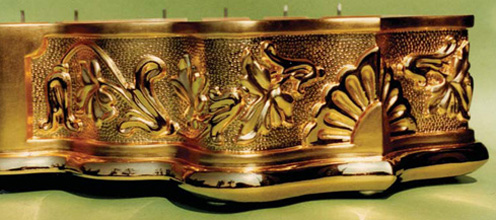The Art of Gilding
Photo: This harp base shows oil gilding in the recessed background and both matte and burnished (shiny) water gilding on the surfaces.
Gold leaf has been a revered surface decoration for thousands of years. Its color, reflectivity and permanence have been associated with beauty and richness in cultures and classes across the globe. There is something in the reflected light from this elemental material that triggers joy, awe, and fascination in the human consciousness as accessed through the eye.
Applying gold leaf requires expertise as well as an artist’s eye. It is a fragile, expensive and devilishly fickle material to work with. When applied with proper precision, the results can create a surface coating unmatched in its perfection. Bernacki & Associates Director of Conservation, Bart Bjornberg, is a Master Gilder with a Masters of Science in Historic Preservation 30 years experience in the field. Conservation & Design asked Bart to share his experiences with gold leaf.
What is the definition of gilding?
In its most basic definition, gilding can be described as the covering of a base or common material with a layer of gold. This layer is achieved through the application of gold leaf to an adhesive which has been applied to the surface to be gilded. It must be noted that there are other, lesser materials used to achieve a gilt surface. Composition leaf which is composed of copper and tin can be used. Just as well, bronze and mica powders mixed in a binder can make a ‘gold’ paint. These surfaces, while capable of being very attractive will never achieve the look of true gold leaf. They will also tarnish and discolor with age, never developing a patina.
The origins of gilding go back many years. Where was it used? Almost all of the world’s cultures have used gold. Tracing the chronology of gold’s use in art and culture reveals its broad appeal. While there are examples of gold foil wrapped objects which date from as early as 3000 BCE, the historical origins of gilding using gold leaf starts later. Egyptian tomb paintings and reliefs from the 23rd century BCE are the first known examples depicting gold being beaten into leaf.
Why is the process of applying gilding considered an “art”?
Gold pounded into leaf is a whisper thin sheet of paradox; properly applied it can transform a piece of ‘common’ material into what looks like solid, polished gold. It is ironically both delicate and strong. A sheet of gold leaf is so fragile that it is impossible to handle barehanded without it tearing and collapsing, practically into thin air. Gold leaf is so fine that it is incapable of supporting its own weight.
Despite the fragile nature of its form, the material itself is so chemically and metallurgically stable that it will not tarnish nor deteriorate as long as the substrate it lies on remains stable. That being said, on an unstable surface simply rubbing a soft, slightly moist cloth across an unsealed gilded surface can actually remove the gold.
You use two techniques in gold leafing. What are they?
Yes, there are two primary techniques used in gold leafing, oil gilding and water gilding. Oil gilding can provide a beautiful surface coating of matte gold. The process is quicker and less labor intensive than water gilding. In many situations it is as durable as water gilding and uses the same gold. Oil gilding must be applied to a completely sealed surface. First an oil size is applied to the surface. Sizes are now made of many different materials but most commonly are a boiled linseed oil. The applied oil is allowed to dry (oxidize) in a dust free environment until the proper tackiness is achieved. Then the gold leaf is applied.
A basic definition of water gilding would be a porous substrate (typically wood), covered with gesso (usually a mix of calcium carbonate and animal hide glue), covered with bole (a mixture of clay and animal or fish based glues), and covered with a layer of gold leaf held to the bole by organic animal or fish based glues. This golden surface can then be left matte or burnished to a mirror-like sheen. Water gilding is typically much more labor intensive than oil gilding but is also capable of achieving a more refined surface and sheen. Consequently it has been reserved for more expensive objects which are seen and experienced at more intimate distances.
On what objects do you typically apply gilding?
Gold leaf has been traditionally used on picture frames, mirror frames, furniture of all shapes and types, art objects (especially sculptural), ceramics, and architectural ornaments. Gilding can achieve the unmatched depth and reflection of a highly burnished glow or wonderfully varied patination of roughly distressed surface revealing the underlying clay. A gilded highlight can fully develop a sculptural detail or enliven a flat surface, as gold can offset natural dark browns and reds as well a brighter white, beige, or pastel shades.
Gold is truly a noble metal; adding importance to any object on which it is applied. Its application is limited only by the imaginations of the designer and the conservator preserving or newly designing a piece. For more information on gilding, please contact Bart at Bernacki & Associates, Inc., (312) 243-5669.



